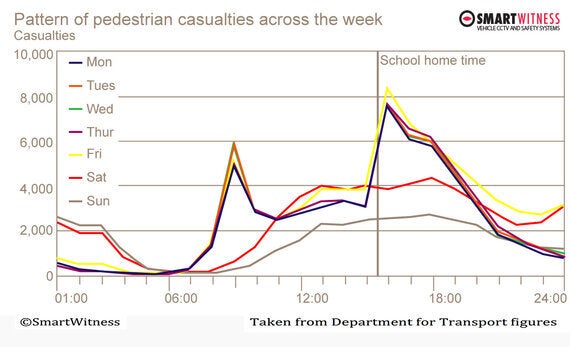The clocks going back on Sunday could cost hundreds of children's lives on UK roads in winter.
Research by road safety company SmartWitness has shown that if we abolished putting the clocks back and persisted with British Summer Time throughout the whole year we would significantly reduce road casualties to pedestrians, cyclists and especially school-children.
Pedestrian Road Deaths Peak At The End Of The Year
Official Department for Transport statistics show that the number of road fatalities and casualties hits a peak in October, November and December, despite the fact that road usage actually drops significantly in those months.
Last year, the total number child casualties on Britain's roads was 16,604, the number killed or seriously injured 2,060 (over 5-a-day) and the peak time for pedestrian casualties was just after 4pm on weekdays, when most children are making their way home from school as you can see from the graph below.

British Summer Time comes to an end at 2am this Sunday (Oct 25) when the clocks go back - giving Britons an extra hour in bed but bringing twilight forward to 4.47pm. By the time of the shortest day on December 22 twilight comes as early as 3.53pm.
It surely can not be unrelated that the numbers of casualties per mile rises steeply in the last quarter of the year when it's dark at school going home time.
Driver and pedestrian reaction times are considerably reduced at night-time and even at urban road speeds of 30mph this can mean the difference between life and death.
Evening Casualties Over A Third Higher Than Mornings
Department for Transport statistics clearly show that the number of accidents in the evening is significantly higher than those in the morning - around 37% higher - so by sticking with British Summer Time and therefore having lighter afternoons and darker mornings it's statistically sound to expect that there would be hundreds of fewer road casualties in the last two months of the year.
The highest rates of vehicle usage comes in Quarter 3 (July, August, September) and yet despite this fact, the casualty rates are still higher in Quarter 4. The casualty figures are lower in Quarter 1, when it also gets dark early in January and February, but this can be explained away because there are far fewer vehicles on the roads at this time of year. Twilight comes much later in March, too - as late as 7.26pm when British Summer Times begins again on March 27 next year.
In the past four consecutive years, the number of deaths per mile has been highest in the last quarter of the year, after the clocks have gone back. Generally it is found that colder weather conditions lead to fewer pedestrian casualties as people use other forms of transport that are less open to the elements, but the statistics clearly show an increase which tends to point to poor light conditions being the main cause.
The last time there was any serious research done on increased casualties due the end of British Summer Time was back in 1970, and there needs to be more modern analysis implemented at the very least because children's and other pedestrians' lives are at stake.